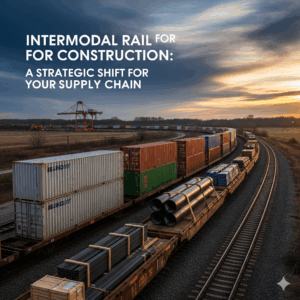This post was last updated on May 22nd, 2025
In today’s fast-paced global shipping environment, ensuring that goods arrive safely and intact is more critical than ever. With rising transportation costs, growing demand for reliability, and increasing pressure to reduce claims and losses, businesses are turning to a smarter solution: intermodal freight. As a hybrid approach that leverages the strengths of multiple modes of transportation – usually rail and truck – intermodal freight transportation is proving to be not only cost-efficient and environmentally sustainable but also one of the safest shipping methods available in 2025.
So what exactly makes intermodal freight safer? To begin with, the containerized nature of intermodal shipping reduces the amount of handling cargo undergoes. Goods are loaded into secure containers and remain sealed throughout most of their journey, even as they switch between transport modes. Fewer touchpoints mean fewer opportunities for human error, damage, or theft. Unlike traditional over-the-road (OTR) shipping, where goods may be loaded and unloaded multiple times, intermodal freight transportation dramatically limits exposure to external risks.
Rail transport, which forms the backbone of most intermodal freight routes, is statistically one of the safest methods of land transport. Trains travel on dedicated tracks, avoiding the congestion, accidents, and unpredictable delays often associated with road travel. As a result, cargo traveling via intermodal rail is far less likely to be impacted by collisions, traffic incidents, or driver fatigue—all major contributors to freight damage in truck-only routes.
Another powerful advantage of intermodal freight is the advanced tracking and monitoring technology now integrated into many intermodal systems. Real-time GPS tracking, automated terminal updates, and digital documentation ensure that businesses have full visibility into their cargo’s location, condition, and estimated arrival time. This transparency not only improves logistical planning but also enhances overall safety by allowing rapid response in case of route deviations, delays, or handling anomalies.
Security is also a major benefit of intermodal freight transportation. Intermodal containers are designed to be tamper-resistant, and most intermodal terminals and rail yards are equipped with high-level security protocols. Unlike traditional shipping yards, intermodal facilities often include controlled access, surveillance, and automated handling systems, which greatly reduce the chances of theft or cargo mishandling. For high-value goods or sensitive shipments, this makes intermodal freight an especially attractive option.
In addition to its built-in safety features, intermodal freight offers resilience. Weather events, road closures, and geopolitical disruptions can wreak havoc on conventional trucking operations. Intermodal networks, with their interconnected systems of rail lines, terminals, and highway access points, provide the flexibility needed to reroute cargo with minimal disruption. This resilience translates to fewer delivery failures and reduced risk of damaged or lost freight.
Finally, intermodal freight is supported by a growing ecosystem of 3PL providers, freight brokers, and software platforms that specialize in optimizing intermodal routes for safety, cost, and timing. With professionals managing scheduling, documentation, container inspections, and risk assessments, shippers gain a safety net of experienced partners who help navigate challenges and ensure smooth, secure delivery.
As we move deeper into 2025, companies that prioritize safety in their logistics operations are increasingly choosing intermodal freight transportation. Whether you’re moving consumer goods, electronics, perishables, or industrial components, intermodal offers a trusted, scalable, and secure method to ship with confidence.

Getting to Know Intermodal Freight Shipping
Intermodal freight transportation has been the industry standard for shipping large quantities of goods internationally, domestically, and within regions.
But what does intermodal mean?
Intermodal freight transportation is a shipping process that combines two or more modes of transport to ship goods across long distances. This could include ground, water, and rail transportation, for instance.
By using intermodal freight shipping, cargo owners can enjoy the benefits of using different modes of transport depending on the situation and the goods that need to be transported.
This flexibility is one of the main reasons intermodal shipping is so popular.
Why is it called intermodal?
Intermodal comes from the Latin words “inter” (between) and “modal” (modes), referring then to shipping goods by splitting transportation between different methods.
What are the types of intermodal transportation?
Contrary to the full truckload shipment, intermodal transportation use several transportation modes to move cargo between points in the supply chain, including:
- Ground transportation with intermodal trucks,
- Freight rail service with trains,
- Water with container ships,
- And air service with planes.
The Common Intermodal Shipping Process
1. Get in touch with intermodal providers
The shipper will want to contact a freight forwarder or an intermodal shipping services provider to understand what is being shipped, the size and weight, and where it needs to go.
2. Defining the optimal route for your intermodal shipments
Once you find the perfect partner and sign an intermodal contract for your intermodal shipping needs, they’ll help you determine the multiple modes of transportation required to complete the shipment.
They will mainly consider factors such as cost, time, type of cargo, and the goods’ final destination.
3. The common intermodal transport operations
Once the intermodal shipping process is initiated, it’s important to keep in mind that there are several handoffs along the way, but everything is happening in a seamless manner.
That’s the beauty of intermodal transportation!
This means that your cargo will be loaded onto a one and only intermodal container, which will then be transferred from truck to train, vessel or plane.
Indeed, every time a carrier gets to an intermodal ramp to make a switch to the next transportation mode of the intermodal journey, the container will be lifted off of the train, truck, or else and then be moved directly onto another intermodal transportation mode without the need to unload the cargo.
This operation can repeat as many times as necessary until it reaches the final destination.
Note: Because the intermodal transportation network uses intermodal containers to move products, it has also been dubbed containerized shipping.

The Main Intermodal Freight Advantages That You Should Know
Intermodal cuts down on wasted space at ports and terminals and reduces highway congestion.
Using the railway system for a good part of intermodal freight transport also helps reduce transportation costs for the shipper. The workforce that needs to intervene is limited; the quantity shipped can be higher, allowing shipment economy of scale.
Overall, rail intermodal traffic is usually a cheaper method to transport goods.
According to the Association of American Railroads, freight railroads would also be four times more fuel-efficient than truck-only shipments, thus inducing a lower carbon footprint.
But fuel efficiency, cost-effective, and environmentally friendly are not the only advantages of intermodal freight shipping.
Safety is another highlight of the intermodal shipping business. Let us tell you why.
Is Intermodal Transportation the Safest Way to Ship Your Cargo?
Intermodal shipping also allows your cargo to be shipped in the same container via the most direct route, which reduces the chance of delays and increases security. This is due to a variety of reasons.
Safe intermodal vehicles
For starters, intermodal transportation uses trucks designed for long-distance hauls. This means they have more safety features than regular semis, like reinforced frames and stronger suspensions.
They also have more modern braking systems, allowing the driver to stop the vehicle quickly if needed.
Slight handling of the merchandise
Intermodal shipments use containers that can be easily transferred from one mode of transport to another – by truck, train, barge, or even aircraft – without unloading their contents.
For the intermodal shippers, this represents a more secure method of transporting goods since it minimizes the amount of handling they receive and, potentially, limits the damages and breakage of the merchandise.
Fewer accidents on the roads
Intermodal freight transportation allows the shipment of products over long distances, usually employing railroads to cover the land-based segments.
And in case of environmental hazards, snow, heavy rain, or others, trains are usually more resilient than road transport.
Fewer losses of goods
Since this transportation involves using an intermodal container with locked doors, the chance of your goods being lost or stolen is significantly lower than the merchandise being transported on the highway.
An improved shipment tracking
Whereas following the route of your intermodal freight shipment was difficult in the past, these times are over.
Most of the intermodal containers are now equipped with a GPS tracking system (satellite or cellular), so you can easily monitor their location and movements at all times, making them more secure for both the logistics companies and consignees.
As you can see, other than its eco-shipping and reduced cost service, intermodal freight shipping is then also a very safe way to ship your goods.
Not only does intermodal transportation use vehicles that are designed for long-haul distances, but they also use containers that can be easily transferred from one mode of transport to another without unloading their contents, limiting loss, damages, and breakage of the goods.
Accidents due to harsh weather conditions can also be limited, thanks to trains on risky segments. Finally, the tracking of intermodal containers has improved in the past years.
Those elements make intermodal freight a reliable, safe, and cost-effective way to transport your cargo.
Are you not convinced yet? Contact us today for more information!
Conclusion
For any business that values cargo integrity, delivery reliability, and long-term shipping sustainability, now is the time to embrace the full advantages of intermodal freight transportation. As we’ve explored, this hybrid approach of leveraging rail and truck transport offers a unique combination of safety, cost-effectiveness, and flexibility that traditional methods simply cannot match. More than just a logistical trend, intermodal freight has emerged as a best-in-class shipping strategy that minimizes risk at every stage of the supply chain.
In the context of safety, intermodal freight leads the way. Trains, which form the core of intermodal movement, are far less likely to be involved in accidents compared to long-haul trucks. This alone drastically lowers the risk of cargo damage and delivery interruptions. When cargo is shipped using intermodal containers, it’s placed into a secure, sealed environment that isn’t opened until it reaches its final destination, dramatically reducing theft, misplacement, and exposure to the elements.
Moreover, today’s intermodal networks are designed with high security in mind. From digitally monitored container yards to biometric-access intermodal terminals, every link in the chain is fortified with technology to prevent loss or compromise. The reduced handling that characterizes intermodal freight transportation not only keeps cargo safer but also decreases human error and the potential for mishandling fragile or sensitive goods.
Another vital consideration is the reduction in environmental and regulatory risks. With governments implementing stricter carbon emission standards and compliance frameworks, businesses that rely heavily on road freight may find themselves facing higher costs and more liability. Intermodal freight, particularly via rail, produces significantly fewer emissions per ton-mile and is viewed as a cleaner, greener alternative. In a business climate increasingly driven by ESG performance, switching to intermodal freight aligns safety with sustainability.
Scalability is another key advantage. As companies grow and shipping volumes increase, intermodal freight transportation provides a scalable model that can handle increased capacity without compromising on safety. Trains can carry large volumes over long distances at a lower cost and lower risk, while trucks can provide the last-mile flexibility needed to complete deliveries efficiently.
Finally, the evolving landscape of shipping technology continues to enhance the safety profile of intermodal freight. AI-powered logistics platforms, automated scheduling, smart sensors in containers, and integrated tracking systems all contribute to proactive risk management. These technologies enable real-time alerts for route changes, temperature fluctuations, or unexpected stops, allowing shippers to act quickly and prevent minor issues from escalating into major problems.
For all these reasons, intermodal freight transportation is not just a safe option – it’s the smartest option for modern logistics. Companies looking to lower claims, reduce cargo damage, improve delivery performance, and meet sustainability targets should strongly consider adopting or expanding their use of intermodal shipping. With the right strategy, partners, and planning, intermodal freight can transform your shipping operations into a model of safety and success.

FAQ
- What is intermodal freight?
Intermodal freight refers to the movement of goods using multiple modes of transportation – typically a combination of truck and rail – without unloading the cargo when switching between modes. The cargo remains sealed in the same container throughout its journey. This approach enhances security, reduces damage, and improves efficiency across supply chains. - Why is intermodal freight considered safer than other shipping methods?
Intermodal freight is safer because it involves fewer cargo handling events, which reduces the chances of damage or theft. Rail transport is statistically safer than long-haul trucking, especially for large volumes over long distances. Containers are sealed and protected, and intermodal terminals are often more secure than standard loading docks. - What types of cargo are best suited for intermodal freight transportation?
Intermodal freight is ideal for non-perishable goods, retail items, electronics, automotive parts, and industrial components. With the availability of refrigerated containers, even temperature-sensitive goods can be transported safely. It’s particularly beneficial for high-volume and long-distance shipments. - Can small businesses use intermodal freight services?
Yes, small and medium-sized businesses can use intermodal freight through partnerships with third-party logistics providers (3PLs) or freight brokers. These partners can consolidate shipments, manage scheduling, and ensure cost-effective intermodal solutions. The scalability and flexibility of intermodal networks make them accessible to businesses of all sizes. - How does tracking work in intermodal freight transportation?
Intermodal freight often utilizes GPS-enabled tracking systems and cloud-based logistics platforms. These tools provide real-time updates on container location, estimated arrival times, and route deviations. Enhanced tracking improves visibility and enables proactive decision-making. - Is intermodal freight cost-effective?
Yes, intermodal freight is often more cost-effective than long-haul trucking, especially for distances over 500 kilometers. Rail transport is more fuel-efficient and can move larger volumes at lower cost. Combining rail and truck allows businesses to balance cost with delivery flexibility. - What are the environmental benefits of intermodal freight?
Rail freight produces significantly fewer greenhouse gas emissions per ton-mile than trucks. Intermodal freight helps companies reduce their carbon footprint and meet environmental compliance goals. This makes it an eco-friendly choice for sustainable logistics. - What security measures are used in intermodal freight terminals?
Many intermodal terminals are equipped with controlled access, 24/7 surveillance, and automated container handling systems. These measures reduce theft, improve safety, and ensure proper cargo management. Containers are also sealed and tamper-evident to enhance security. - How does intermodal freight help reduce cargo damage?
Because cargo is loaded once and remains sealed, there are fewer opportunities for damage due to handling. The smoother ride of rail transport also helps protect fragile goods. Additionally, specialized containers and load-securing practices add another layer of protection. - Are there limits to what intermodal freight can transport?
Most general freight is suitable for intermodal shipping, but extremely time-sensitive or oversized cargo may require alternative solutions. There are also weight and dimension regulations that must be followed. However, many container types exist to handle diverse cargo requirements. - What role do 3PLs play in intermodal freight transportation?
Third-party logistics providers coordinate the various components of intermodal freight, from route planning to documentation to real-time tracking. They help businesses access competitive rates and manage regulatory compliance. Working with a 3PL can significantly streamline intermodal operations. - How can I get started with intermodal freight for my business?
Begin by assessing your shipping lanes, volumes, and cost structure to determine if intermodal is a fit. Partnering with a freight broker or 3PL is often the easiest way to access intermodal networks. With a bit of planning, you can quickly implement a safer, more reliable shipping strategy using intermodal freight transportation.
How We Can Help
For businesses looking to optimize their freight shipping with reliable, efficient, and cost-effective solutions, RailGateway.ca is your trusted partner in intermodal logistics. Whether you’re new to freight trains or want to enhance your existing supply chain, our team of intermodal experts is ready to guide you every step of the way.
Contact RailGateway.ca today for a free quote or to speak directly with one of our experienced intermodal specialists. Let us help you unlock smarter, smoother shipping solutions tailored to your unique needs.
Visit RailGateway.ca or call us to get started on transforming your freight shipping strategy in 2025 and beyond.





